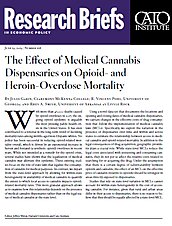With more than 47,000 deaths caused by opioid overdoses in 2017, the ongoing opioid epidemic is arguably the most pressing public health crisis in the United States. It has even contributed to a reversal in the long-term trend of declining mortality rates among middle-aged non-Hispanic whites. No policy has been successful in reducing opioid-related mortality overall, which is driven by an exponential increase in heroin and fentanyl (a synthetic opioid) overdoses in recent years. While not intended as a remedy for the opioid crisis, several studies have shown that the legalization of medical cannabis may alleviate this epidemic. These existing studies focus on the role of state laws that legalize the consumption of cannabis for medical purposes. In contrast, we depart from the state-level approach by allowing for within-state heterogeneity in availability of medical cannabis to quantify the extent to which local access to cannabis impacts opioid-related mortality rates. This more granular approach allows us to examine how this relationship depends on the presence of medical cannabis dispensaries rather than on the legal status of medical cannabis at the state level.
Using a novel data set that documents the locations and opening and closing dates of medical cannabis dispensaries, we capture changes in the effective costs of drug consumption that follow the implementation of medical cannabis laws (MCLs). Specifically, we exploit the variation in the presence of dispensaries over time and within and across states to estimate the relationship between access to medical cannabis and opioid-related mortality. In addition to the legal consequences of drug acquisition, geographic proximity plays a crucial role. While state-level MCLs reduce the legal costs associated with possessing and consuming cannabis, they do not per se affect the relative costs related to searching for or acquiring the drug. Under the assumption that there is a certain degree of substitutability between opioids and cannabis, the effect of an MCL on the effective price of cannabis (relative to opioids) should be strongest in areas directly exposed to dispensaries.
To the extent that dispensaries are not uniformly distributed within a state, it is difficult to infer the effects of cannabis legalization from policy variation on the state level. From a public policy perspective, those estimates may provide policymakers with conclusions about the convenience of MCLs that are not grounded in the effects of cannabis per se. By capturing the effect of the presence of a dispensary on opioid mortality at the county level, our estimates come closer to capturing the true effect of cannabis on opioid-related mortality.
Departing from existing studies, our research design compares counties with and without dispensaries within the same state. Therefore, we are able to control not only for the legal status of medical cannabis but also for any unobserved factors that may drive differences in opioid use between states. In addition, we allow for persistent unobserved county-specific differences and state-specific trends in opioid mortality. Hence, our identification strategy relies on temporal variation in the access to medical cannabis within counties. This research design allows us to isolate the impact of a dispensary on opioid-related deaths more effectively than prior literature and brings our estimates closer to providing a causal interpretation. Furthermore, our work addresses the criticism that the state-level analyses used in existing studies do not provide conclusive evidence because unobserved differences between states could explain the estimated relationship between medical cannabis legalization and opioid mortality
Using time variation in dispensary opening and estimating Poisson regressions of county-level deaths caused by opioid overdoses, we find a significant decline in mortality in counties where dispensaries are present. While medical cannabis dispensaries reduce opioid-related mortality overall, our results are strongest for heroin overdoses. Specifically, we find that mortality related to any opioids and prescription opioids declines by 6–8 percent. For heroin, the reduction in mortality amounts to 10 percent, although this effect is less precisely estimated. Importantly, these effects are limited to counties where dispensaries opened, and do not apply to nondispensary counties in states that have legalized medical cannabis. In fact, with the exception of heroin-related overdoses, MCLs themselves have a positive effect on opioid-related mortality. That is, while legalizing medical cannabis is not associated with lower levels of opioid-overdose mortality, the presence of dispensaries has a large negative impact on the number of opioid-related deaths.
These estimates imply that 10 per 100,000 (8.5 percent) fewer opioid-related deaths would have occurred between 1999 and 2015 if states that legalized medical cannabis during this period had introduced dispensaries in all counties as soon as the MCL came into effect. Our results have direct policy implications, since we find that MCLs lead to a reduction in opioid-related deaths that is limited to counties where access to medical cannabis is facilitated through the presence of dispensaries.
NOTE:
This research brief is based on Julio Garin, R. Vincent Pohl, and Rhet A. Smith, “The Effect of Medical Cannabis Dispensaries on Opioid- and Heroin-Overdose Mortality,” Claremont McKenna College Robert Day School of Economics and Finance Research Paper no. 3270101, November 2018, https://papers.ssrn.com/sol3/papers.cfm?abstract_id=3270101.
About the Authors

This work is licensed under a Creative Commons Attribution-NonCommercial-ShareAlike 4.0 International License.
